Are you giving your indoor plants the nourishment they need to thrive, or could a simple change in your fertilizing routine unlock their true potential? Fertilizing indoor plants is a crucial aspect of maintaining healthy and thriving foliage. While it may seem daunting, with the right knowledge and techniques, you can ensure that your indoor plants receive the necessary nutrients for optimal growth. In this comprehensive guide, we will explore the importance of understanding plant nutrition, choosing the right fertilizer, basic fertilizing practices, application techniques, special considerations for different plant types, organic fertilizer options, troubleshooting and maintenance tips, and a conclusion with key takeaways. By following these essential tips, you’ll be able to provide your indoor plants with the nourishment they need to flourish.
Key Takeaways:
- Fertilizing indoor plants is essential for their health and growth.
- Understanding plant nutrition is key to choosing the right fertilizer.
- Proper fertilizing techniques and application methods ensure effective nutrient absorption.
- Different plant types have specific fertilizing requirements.
- Organic fertilizers offer sustainable and natural options for indoor plant care.
Introduction
In the world of indoor gardening, understanding the importance of fertilizing your plants is paramount. While it’s easy to assume that houseplants can thrive on their own, they actually rely on proper nutrition to support their growth and overall health. In this section, we will delve into why fertilizing indoor plants is crucial and how it can benefit your foliage. By recognizing the signs that indicate your houseplant needs fertilizer and establishing a fertilizing schedule, you can ensure that your indoor plants receive the necessary nutrients for optimal growth.
As plants grow in enclosed environments, such as your home, they rely heavily on the nutrients available in the soil. Over time, these nutrients become depleted, leading to a deficiency that can impact the health and vitality of your indoor plants. Fertilizing provides a solution by replenishing those essential nutrients and ensuring that your plants have everything they need to thrive.
So, how do you know when your houseplant needs fertilizer? Some common signs include slow or stunted growth, pale or yellowing leaves, and weak or drooping stems. These indications often point to a lack of nutrients, making fertilizing a critical step to address these issues.
To ensure consistent nourishment, it’s essential to establish a fertilizing schedule for your indoor plants. This schedule will depend on the specific needs of your plants, their growth rate, and the type of fertilizer you’re using. By adhering to a schedule, you can provide your plants with a steady supply of nutrients, promoting healthy growth and preventing nutrient deficiencies.
Understanding Plant Nutrition
To effectively fertilize indoor plants, it’s crucial to understand their nutritional needs. This section will delve into the essential elements required for plant growth, including carbon, hydrogen, oxygen, nitrogen, phosphorous, potassium, calcium, magnesium, sulfur, iron, zinc, molybdenum, boron, copper, manganese, and chlorine. We’ll focus on the macronutrients nitrogen, phosphorous, and potassium, which play vital roles in photosynthesis, root development, and overall plant health. An understanding of plant nutrition will enable you to choose the right fertilizer and address any nutrient deficiencies.
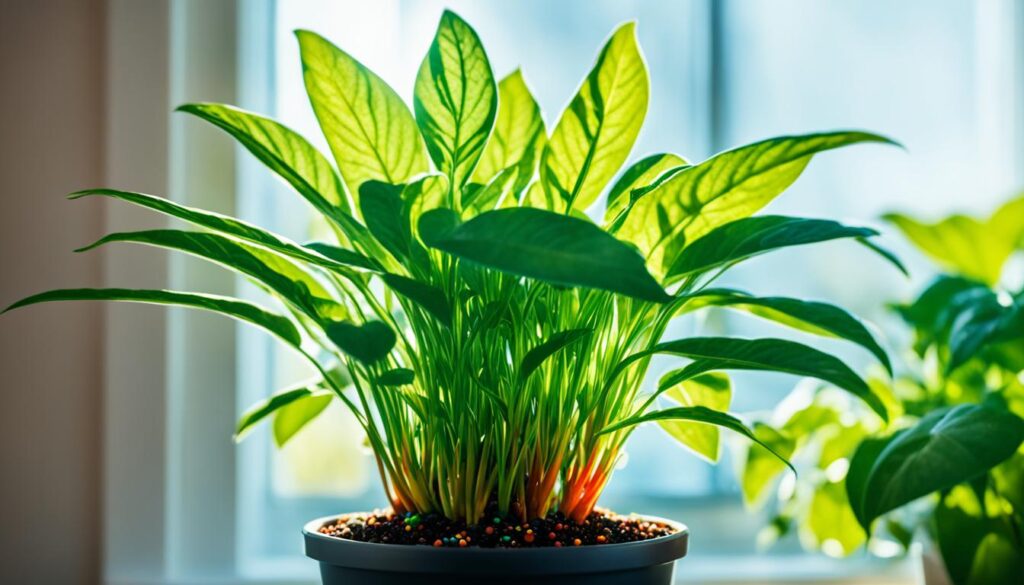
Note: The image above illustrates the importance of indoor plant nutrition.
Choosing the Right Fertilizer
The N-P-K Ratio and Its Significance
Selecting the right fertilizer is crucial when it comes to providing your indoor plants with the ideal balance of nutrients. One important factor to consider is the N-P-K ratio, which represents the proportions of nitrogen (N), phosphorus (P), and potassium (K) in a fertilizer. The N-P-K ratio plays a significant role in determining the fertilizer’s effectiveness and its suitability for different plant types.
Nitrogen (N) is responsible for promoting leaf and stem growth. Phosphorus (P) supports root development, flower production, and overall plant health. Potassium (K) enhances disease resistance, nutrient absorption, and the overall quality of the plant.
Understanding the N-P-K ratio helps you choose a fertilizer that matches your indoor plants’ specific needs. For example, if your plants require more foliage growth, a fertilizer with a higher nitrogen content would be suitable. If you want to encourage blooming and root development, a higher phosphorus content would be beneficial.
When deciding between liquid and granular fertilizers, it’s important to consider their advantages and disadvantages. Liquid fertilizers are fast-acting and provide quick nutrient absorption, making them suitable for frequent applications. They are easily soluble in water, making them accessible to plants through root uptake or foliar feeding. Granular fertilizers, on the other hand, release their nutrients slowly over time, providing a longer-lasting effect. They are convenient for plants that require less frequent fertilization.
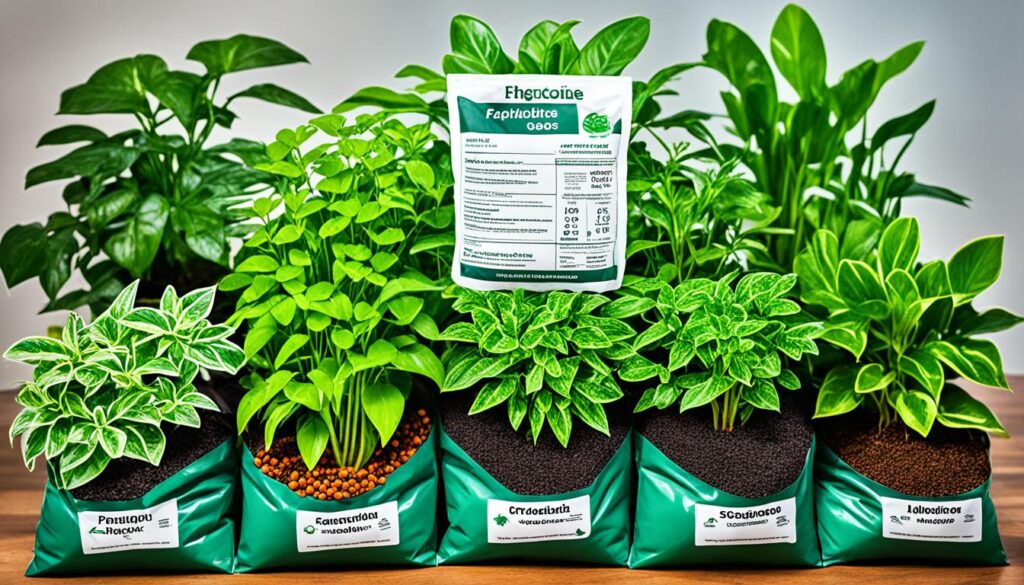
| Fertilizer Type | Advantages | Disadvantages |
|---|---|---|
| Liquid fertilizer | – Fast-acting | – Requires frequent applications |
| Granular fertilizer | – Long-lasting | – Releases nutrients slowly |
Ultimately, the choice between liquid and granular fertilizer depends on your preferences, the specific needs of your indoor plants, and your fertilization routine. By understanding the N-P-K ratio and considering the pros and cons of different fertilizer types, you can make an informed decision and provide your indoor plants with the nutrients they need to thrive.
Fertilizing Basics
Properly fertilizing your indoor plants is essential for their growth and overall health. In this section, we will cover the fundamental aspects of fertilizing indoor plants, including application methods and frequency. By understanding these basics, you’ll be able to provide your houseplants with the necessary nutrients they need to thrive.
Application Methods
There are several application methods you can use to fertilize your houseplants. Here are some common techniques:
- Drenching: This method involves pouring the fertilizer solution directly onto the soil until it flows out of the drainage holes. It is effective for evenly distributing nutrients throughout the root zone.
- Top-dressing: With this method, you apply the fertilizer on top of the soil without mixing it in. It is ideal for slow-release fertilizers or organic amendments.
- Foliar feeding: This technique involves spraying the fertilizer solution onto the leaves of the plants. It allows for quick absorption of nutrients and is beneficial for plants with nutrient deficiencies.
Frequency of Fertilization
The frequency of fertilization varies depending on the specific needs of your indoor plants. As a general guideline:
- Fertilize actively growing plants every two to four weeks during the growing season.
- Reduce fertilization frequency to once every 4-8 weeks during the dormant period.
- Take into account the specific instructions on the fertilizer package and adjust the frequency accordingly.
Remember to always follow the recommended dosage to avoid over-fertilization, which can damage your plants. Dilute the fertilizer according to the instructions and apply it evenly to prevent nutrient imbalances.
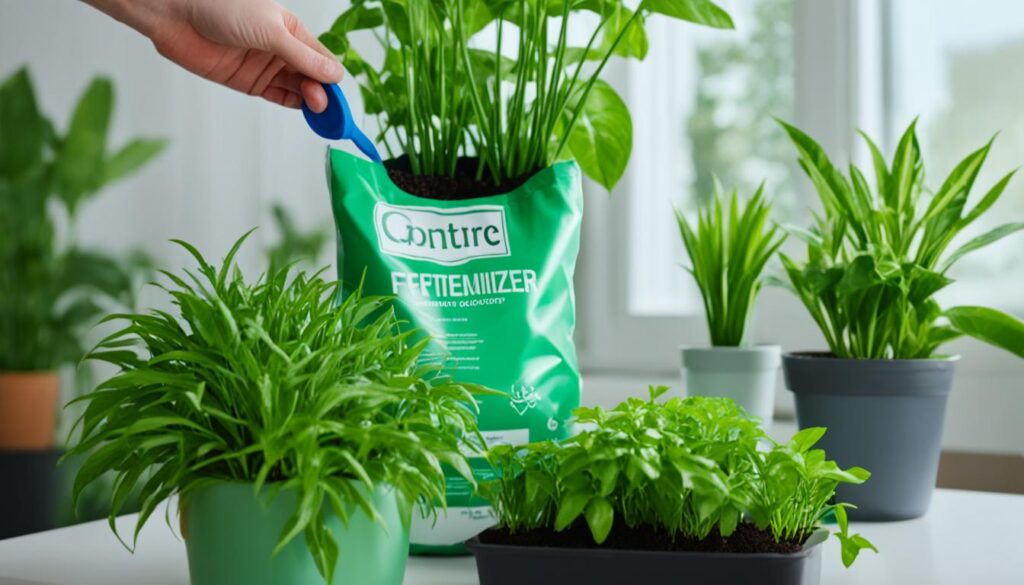
Application Techniques
Applying fertilizers to indoor plants requires the right tools and equipment to ensure proper distribution. By mastering the application techniques, you’ll be able to deliver nutrients efficiently to your indoor plants. Here are some essential tools and equipment for applying fertilizers to your houseplants:
- Hand Sprayers: Hand sprayers are useful for applying liquid fertilizers. They provide a controlled and even distribution of the fertilizer solution to the foliage and soil.
- Watering Cans: Watering cans with a narrow spout are suitable for applying liquid or granular fertilizers directly to the soil. They allow for precise application at the base of the plants.
- Fertilizer Spoons: Fertilizer spoons are handy for measuring and distributing granular fertilizers accurately. They help prevent over-application.
- Measuring Cups: Measuring cups are essential for accurately measuring liquid fertilizers, ensuring the correct dilution ratio.
- Fertilizer Injectors: Fertilizer injectors can be attached to irrigation systems to deliver a controlled amount of fertilizer to indoor plants.
- Fertilizer Sticks: Fertilizer sticks are convenient for slow-release fertilization. They are inserted into the soil and provide a continuous supply of nutrients over time.
It is important to use the right dilution ratios when applying liquid fertilizers. Follow the instructions on the fertilizer packaging or consult with a gardening expert to determine the appropriate ratio for your specific fertilizer and plant type. Different plant types may have different fertilizer requirements, so it’s crucial to understand their needs and apply the fertilizers accordingly.
Mastering the application techniques and using the right tools and equipment will help ensure that your indoor plants receive the necessary nutrients for optimal growth and health.
Equipment for Applying Fertilizers
| Tools and Equipment | Description |
|---|---|
| Hand Sprayers | Useful for applying liquid fertilizers to both the foliage and soil, providing controlled and even distribution. |
| Watering Cans | With a narrow spout, watering cans allow for precise application of liquid or granular fertilizers at the base of the plants. |
| Fertilizer Spoons | Handy for measuring and distributing granular fertilizers accurately, preventing over-application. |
| Measuring Cups | Essential for accurately measuring liquid fertilizers and ensuring the correct dilution ratio. |
| Fertilizer Injectors | Attachable to irrigation systems, fertilizer injectors provide a controlled amount of fertilizer to indoor plants. |
| Fertilizer Sticks | Convenient for slow-release fertilization, fertilizer sticks are inserted into the soil and provide continuous nutrient supply. |
Special Considerations for Different Plant Types
In order to effectively fertilize your indoor plants, it’s important to understand their specific nutritional requirements. Different plant genera have varying needs when it comes to fertilizing. By tailoring your fertilization approach to each plant type, you can ensure optimal growth and health.
Let’s take a closer look at the nutritional requirements for some common indoor plant genera:
| Plant Genus | Nutritional Requirements |
|---|---|
| Calathea | High in nitrogen and potassium |
| Maranta | Rich in organic matter and humidity |
| Anthurium | Requires balanced fertilizer and bright indirect light |
| Spathiphyllum | Needs a balanced blend of nutrients and regular watering |
| Zamioculcas | Thrives on a well-balanced fertilizer and infrequent watering |
| Pachira | Requires a balanced fertilizer and moderate lighting |
| Oxalis | Needs a balanced formula with higher phosphorous content |
| Peperomia | Requires a well-balanced fertilizer with moderate nitrogen levels |
| Ficus | Thrive on a balanced fertilizer and bright indirect light |
| Cissus | Needs a well-balanced fertilizer with higher phosphorous levels |
| Strelitzia | Requires a higher nitrogen content and bright light conditions |
| Alocasia | Needs a well-balanced formula and high humidity |
| Syngonium | Requires a balanced blend of nutrients and filtered sunlight |
| Epipremnum | Thrives on a balanced formula and moderate lighting |
| Monstera | Requires a balanced fertilizer and bright indirect light |
Understanding the fertilizing requirements for each specific plant type will allow you to provide targeted care and ensure that your indoor plants receive the necessary nutrients for optimal health and growth.
Organic Fertilizing Options
For those who prefer organic options, this section will explore the benefits and methods of organic fertilization for indoor plants. Organic fertilizers are derived from natural sources and offer several advantages over synthetic alternatives. They promote sustainability, reduce the risk of chemical buildup in the soil, and create a natural environment for your houseplants to thrive.
One of the most popular organic fertilizers for houseplants is compost. Composting involves the decomposition of organic matter, such as food scraps, leaves, and lawn clippings, into a nutrient-rich soil amendment. You can create your own compost pile or purchase ready-to-use compost from gardening centers.
Another excellent option is worm castings, also known as vermicompost. Worm castings are the waste produced by earthworms after consuming organic matter. They are rich in valuable nutrients and microorganisms that enhance soil fertility. You can either buy worm castings or set up a vermicomposting system at home.
If you enjoy DIY projects, you can make your own plant-based fertilizers using organic ingredients. One popular recipe involves steeping banana peels in water to create a potassium-rich fertilizer. Similarly, you can make nettle or comfrey tea by soaking the leaves in water to release their nutrients. These homemade fertilizers are cost-effective and easy to prepare.
Remember that organic fertilizers generally provide a slow and steady release of nutrients, which may require more frequent applications compared to synthetic fertilizers. It’s important to follow the recommended application rates and schedules to avoid over or under fertilizing your indoor plants.
By incorporating organic fertilizing options into your indoor gardening routine, you can ensure the long-term health and vitality of your houseplants while promoting a more sustainable and eco-friendly approach.
Troubleshooting and Maintenance
Fertilizing indoor plants comes with its own set of challenges. Despite your best efforts, you may encounter common fertilizer-related issues that can affect the health and vitality of your plants. In this section, we will address these problems and provide troubleshooting tips and solutions to help you maintain optimal plant nutrition. By effectively troubleshooting and resolving these issues, you can ensure the long-term well-being of your indoor plants.
Common Fertilizer-Related Issues and Their Solutions
1. Nutrient Deficiencies: One of the most common problems encountered when fertilizing indoor plants is nutrient deficiencies. Plants require a balanced supply of essential nutrients to thrive. However, certain factors such as improper pH levels, insufficient fertilizer application, or lack of specific nutrients can lead to deficiencies. The table below highlights common nutrient deficiencies and their symptoms:
| Nutrient Deficiency | Symptoms |
|---|---|
| Nitrogen (N) | Pale or yellow leaves, stunted growth |
| Phosphorous (P) | Purple or dark leaves, poor flowering |
| Potassium (K) | Brown leaf edges, weak stems |
| Iron (Fe) | Yellowing between leaf veins |
| Zinc (Zn) | Small, malformed leaves |
To address nutrient deficiencies, consider adjusting the pH of your soil or choosing a fertilizer with a higher concentration of the lacking nutrient. Additionally, follow the recommended fertilizing schedule and ensure proper application techniques.
2. Fertilizer Burn: Over-fertilization can cause fertilizer burn, characterized by brown or yellow patches on the leaves, wilting, or slow growth. This occurs when the concentration of fertilizer salts becomes too high, damaging the plant’s roots and affecting its ability to absorb water and nutrients. To prevent fertilizer burn, dilute the fertilizer according to the manufacturer’s instructions and avoid applying more than the recommended amount. If fertilizer burn occurs, flush the soil with water to remove excess salts and adjust your fertilizing practices.
3. Over-Fertilization: While providing nutrients to your indoor plants is essential, it is possible to over-fertilize them. Excessive fertilization can result in salt buildup in the soil, causing root damage and nutrient imbalances. Signs of over-fertilization include yellowing leaves with burned edges, wilting, or stunted growth. To avoid over-fertilization, carefully measure and follow the recommended fertilizer application rates. Remember that less is often better than more when it comes to fertilizing.
By addressing these common fertilizer-related issues and implementing appropriate solutions, you can ensure the optimal growth and health of your indoor plants. Regular monitoring and adjustment of your fertilizing practices will contribute to the overall well-being and longevity of your indoor garden.
Conclusion
Now that you’ve reached the end of this comprehensive guide on fertilizing indoor plants, let’s summarize the key takeaways and essential tips. By understanding the importance of plant nutrition, you can ensure that your indoor plants receive the necessary nutrients for optimal growth and health.
Firstly, it’s crucial to choose the right fertilizer for your indoor plants. Consider the N-P-K ratio, which represents the proportions of nitrogen, phosphorous, and potassium in the fertilizer. This ratio will vary depending on the specific needs of your plants. Additionally, organic fertilizing options, such as compost and homemade plant-based fertilizers, provide sustainable and natural alternatives.
Next, implementing proper application techniques is vital. Whether you prefer drenching, top-dressing, or foliar feeding, understanding the frequency of fertilization and dilution ratios will help prevent over-fertilization and ensure efficient nutrient delivery.
By following these guidelines and incorporating the tips discussed throughout this guide, you’ll be equipped to fertilize your indoor plants effectively. Providing them with the necessary nutrients will promote their overall health and growth, enhancing the beauty and vitality of your indoor space.
For more valuable Expert Tips check out our comprehensive Houseplant Guide to Tips for Indoor Plant Care.
If you happen to be nearby, stop in at The Landscape Connection and say Hi. Michelle and I would love to meet you.
FAQ
Why is fertilizing indoor plants important?
Fertilizing indoor plants is important because plants rely on the nutrients provided through fertilizers in enclosed environments. Regular fertilization ensures that your houseplants receive the necessary nutrients for healthy growth.
What are the signs that my houseplant needs fertilizer?
Common signs that your houseplant needs fertilizer include slow growth, pale or yellow leaves, lack of flowering, and nutrient deficiency symptoms such as yellowing or browning of leaves.
When should I fertilize my indoor plants?
Indoor plants should be fertilized during the growing season, typically in spring and summer. It’s important to follow a consistent fertilizing schedule to provide your plants with a steady supply of nutrients.
What are the essential elements for plant growth?
Essential elements for plant growth include nitrogen, phosphorous, potassium, carbon, hydrogen, oxygen, calcium, magnesium, sulfur, iron, zinc, molybdenum, boron, copper, manganese, and chlorine. These elements play vital roles in photosynthesis, root development, and overall plant health.
What is the significance of the N-P-K ratio in fertilizers?
The N-P-K ratio represents the proportions of nitrogen (N), phosphorous (P), and potassium (K) in a fertilizer. Understanding the N-P-K ratio helps you choose the right fertilizer for specific plant needs, as different plants require different nutrient ratios.
Should I use liquid or granular fertilizer for my plants?
The choice between liquid and granular fertilizer depends on personal preference and the specific needs of your plants. Liquid fertilizers provide fast-acting nutrients, while granular fertilizers offer slow-release nourishment. Both have their advantages and disadvantages.
How often should I fertilize my indoor plants?
The frequency of fertilization depends on factors such as plant type, growth rate, and fertilizer type. As a general guideline, most indoor plants benefit from monthly or bi-monthly fertilization during the growing season.
What application methods should I use for fertilizing indoor plants?
Common application methods for fertilizing indoor plants include drenching, top-dressing, and foliar feeding. The choice of method depends on the plant’s needs and the type of fertilizer being used.
What tools and equipment do I need for applying fertilizers to indoor plants?
Tools and equipment for applying fertilizers to indoor plants may include hand sprayers, watering cans, measuring spoons or cups, and a pH testing kit. Using the right tools ensures proper distribution and application of the fertilizer.
What are the fertilizing considerations for different plant types?
Different plant types have specific nutritional needs. It’s essential to understand the fertilizing requirements for common indoor plant genera, including Calathea, Maranta, Anthurium, Spathiphyllum, Zamioculcas, Pachira, Oxalis, Peperomia, Ficus, Cissus, Strelitzia, Alocasia, Syngonium, Epipremnum, and Monstera. Each plant type may have different fertilizing needs.
Are there organic fertilizers available for indoor plants?
Yes, there are organic fertilizers available for indoor plants. Options include compost, worm castings, and homemade plant-based fertilizers. These organic fertilizers provide natural and sustainable nourishment for your houseplants.
What are common fertilizer-related issues for indoor plants?
Common fertilizer-related issues for indoor plants include nutrient deficiencies, fertilizer burn, and over-fertilization. These problems can be addressed through proper troubleshooting and maintenance.
What are the key takeaways for fertilizing indoor plants?
The key takeaways for fertilizing indoor plants include understanding plant nutrition, choosing the right fertilizer, implementing proper application techniques, and addressing specific plant needs. By following these guidelines, you can provide your indoor plants with the necessary nourishment for optimal growth and health.


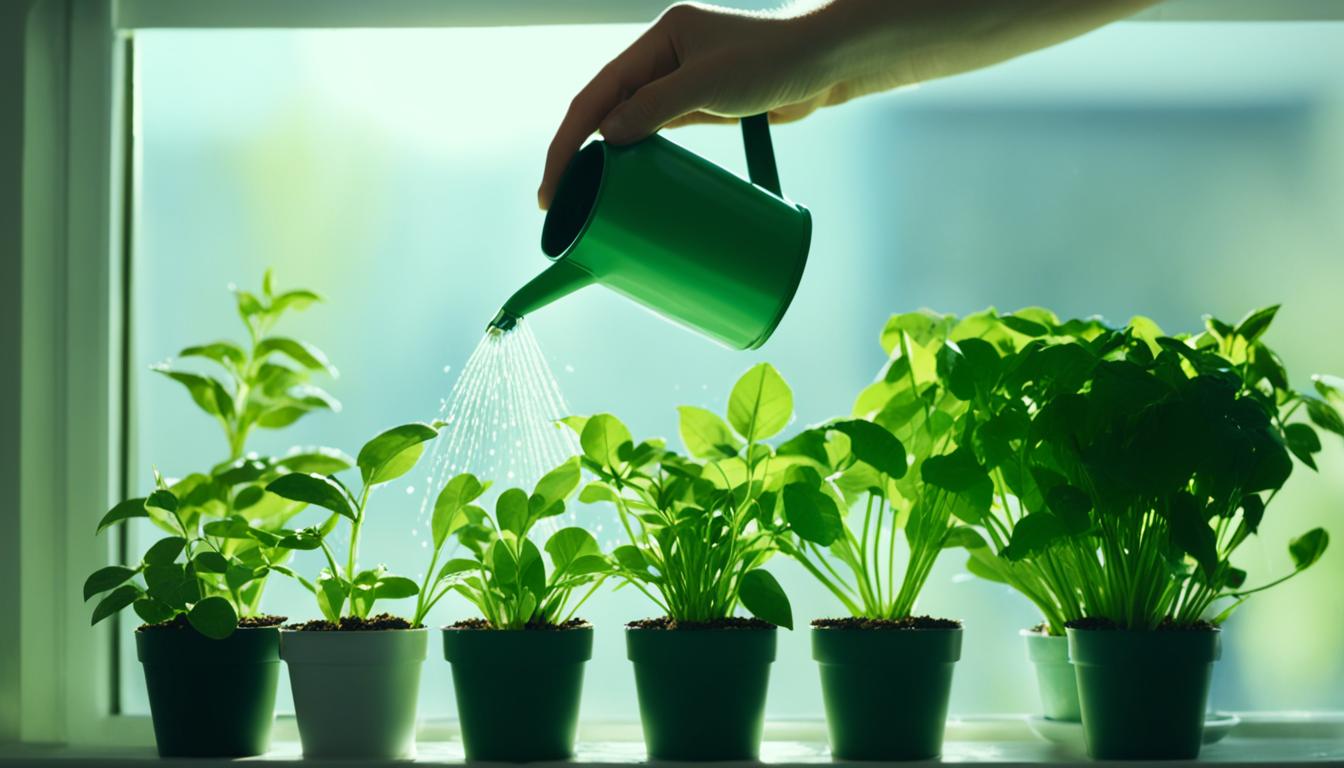

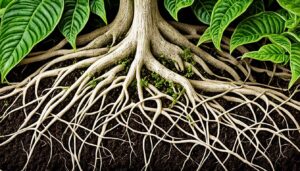
Pingback: Calathea, A Stunning, Non-Toxic Houseplant with Vibrant Foliage
Pingback: Umbrella Tree, The Hardy, Tall Houseplant That Brings Life to Any Corner
Pingback: Chinese Money Plant, The Trendy, Humidity-Loving Houseplant You Need
Pingback: Arrowhead plant, Why This Fast-Growing Vine Thrives in Moist Environments